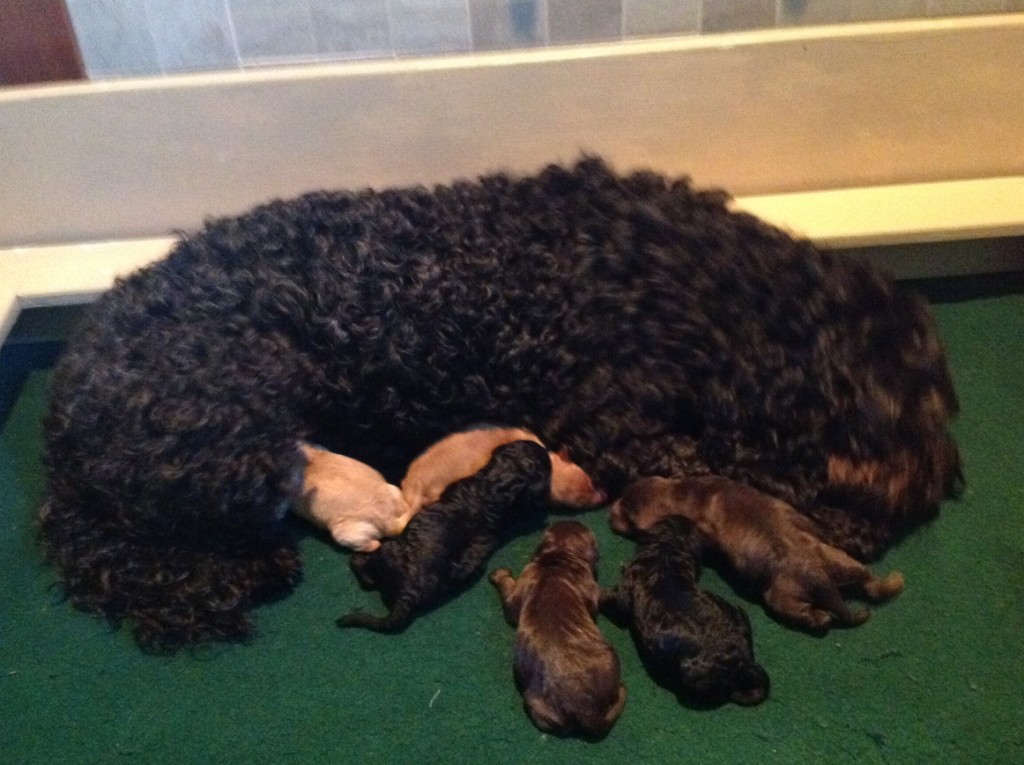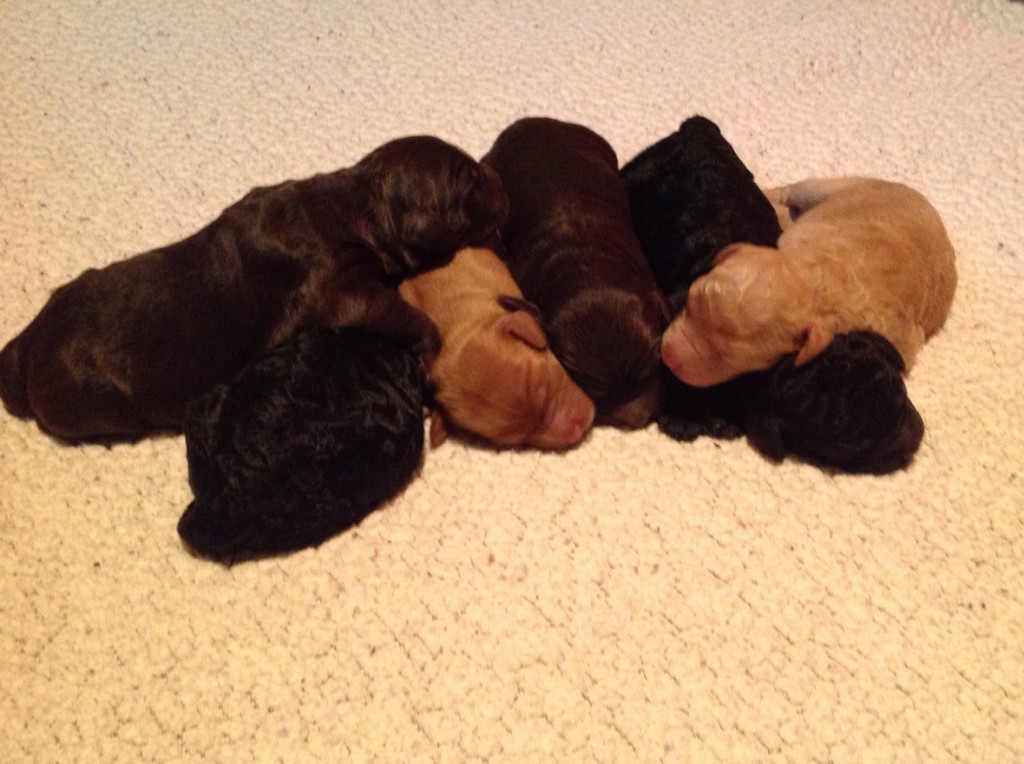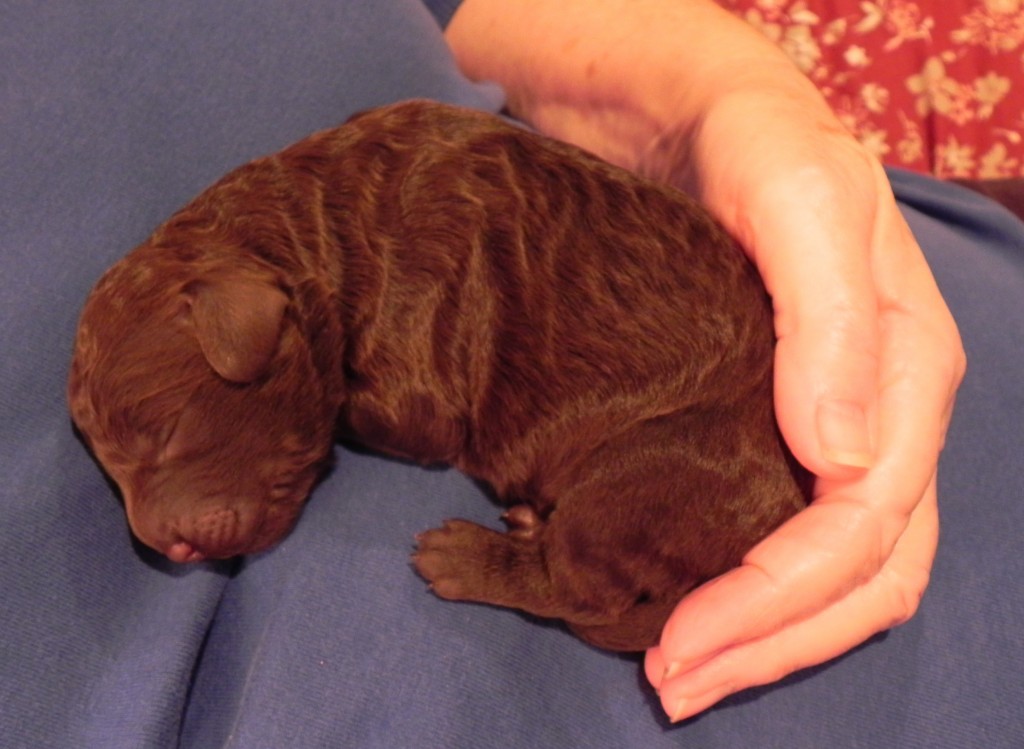
Our Australian Labradoodle Madelyn “Maddie” gave birth to six puppies on Monday, September 1. We stayed up all night with her as she paced and panted. This is her second litter and we’ll have her spayed in a few months so this will be her last litter.
Maddie is one of our two breeding dogs. We co-own Maddie and Tillie with Liz Ferris of “Country Labradoodles” in Paso Robles. She sells beautiful labradoodles that are in a line of dogs from Australia and bred for service dogs and therapy dogs for people with allergies. After owning Labrador retrievers, I was looking for dog with the same happy disposition but having non-shedding coats. I found this in the labradoodle.
The new puppies are three days old now. We are already starting to handle them. Madelyn watches us as we carefully lift them, snuggle them, and set them down. She needs to trust us with her babies. Within a day or two, we will begin the Bio-Sensor Program or “Super Dog” stimulation each day with each pup.
Early neurological stimulation will have important and lasting effects on puppies. Please see the article published by Dr. Carmen Battaglia, report on research by the U.S. Military program called “BioSensor” or “Super Dog” on the website “Breeding Better Dogs”.

Week 1 and 2: Puppies are born helpless and completely dependent on their moms. They respond to the warmth, touch, and the smell of her. The puppies crawl in a circle moving their heads from side to side when trying to find their mother for food or warmth. Their eyes and ears are closed. There is some vocalizations at this stage, especially if hungry, cold or in distress. A good mother is quick to respond to vocalization.
Week 3 and 4: The puppies’ eyes will open. There is a rapid development of motor skills. Focused vision begins at 18-21 days. They begin getting their teeth. The puppies begin to walk more and leave the nest to eliminate. Yeahhhh!
We increase individual attention, and add toys and other visual objects to their whelping bed and play area. The mother will start to spend short times away from the puppies. Puppies will begin using all of their senses. They need a stable environment and the influence from their mom. Puppies will soon begin play fighting, barking increases. They begin to eat real food, but the mother will continue nursing them. Whenever we feed the puppies, we use the opportunity to teach the command “sit”. You’d be surprised how quickly they learn this command in order to get their bowl of food.
During this period we introduce a variety of new noises: T.V, radio, vacuums, hair dryer, slamming doors. We even have a tape of “city noises”. We also introduce new areas of the house. We invite our company to visit and cuddle the puppies as long as they take off their shoes and wash their hands before entering the dog area.
Week 5 and 6: During these weeks. play behavior becomes much more sophisticated, including growling, chasing, and “kill” games (shaking and holding down the toy). They are eating well now, and will start to be weaned. There is much research supporting the conclusion that puppies raised in an environment lacking challenges are more likely to develop into fearful, less successful adults. Home-raised puppies get so much more exposure to everyday challenges.
Many new objects are introduced, steps, tunnels, blocks of wood, cardboard boxes and anything else we have around. The puppies are encouraged to follow our voice and spend time outside with us. Handling continues making eye contact and talking to the puppies several times a day, including play interactions such as fetching toys.
Week 7 and 8: During this time, more time is spent individually with each puppy, adding new objects for challenge: a maze of objects to run around, larger items to climb over and manipulate. Each puppy is separated for short periods of time from the rest of the litter, teaching more independence and preventing separation anxiety problems later in life. This also encourages bonding and acceptance of humans. And it’s fun to have them alone for a while.
Puppies will experience a trip to the vet for a puppy check-up, meet new people, go for rides in the car, be introduced to walking on a leash and learning to navigate stairs. They will continue to be introduced to new toys, objects, sights, and sounds. Crate training begins. All of this will ensure that all of our puppies make a smooth transition into their new homes with as little stress as possible.
After week 8: Dogs with proper stimuli and socialization will learn quickly and not develop self-destructive behaviors like coat chewing, licking, etc.
Puppies continue to need to be exposed to a wide array of smells, textures, surfaces, sounds, vibrations, tastes, sights, and a variety of people, especially children. The more chances a puppy has to be exposed to something new during the critical socialization periods, the less bothered it will be throughout the rest of its life when confronted by new or frightening things.
Weaning should be complete after 8 weeks, however the mom will continue to play with and teach the puppies. The puppies are very curious. They have very little sense of fear now and will approach and investigate anything and everything.
House breaking begins and the pups learn to eliminate outdoors. Puppies learn to be enjoy grooming and are bathed.
At some time, during the eight weeks we have our puppies in our home, I write a paragraph regarding the personality of each individual puppy. Labradoodles, and in fact all puppies, have specific temperaments at a very early age. Knowing them can help make a perfect match between puppy and owner. Most puppies will be placed in their new homes between 8 and 10 weeks. Learning how to live in a family will be an exciting process. I’ve enjoyed getting pictures and little videos of progress from “forever” families. Raising puppies is very rewarding. I love playing a part in what can be a most exciting part of peoples’ lives.


interested in a male labradoodle preferably less than 30lbs.
Thank you
There are two puppies left from this litter, Donna. You can see their pictures on the “Country Labradoodles
” site. Go to http://australian-labradoodles.com. Elizabeth Ferris (the co-owner) of our two girls keeps the puppies after 8 weeks of age. She crate trains them and gets them ready to go to homes. Our little boy, Micky, is a lively, fun-loving boy. A real sweetheart. He will be around 30-35 lbs. Good luck.Hello , my name is laura , I live in Spain . I’m interested in a large labradoodel australian red and male sex, I wonder if they sent to Spain and what would be the price, many thanks for the info , Greetings
Hi Laura. We co-own our two girls with a licensed breeder. She does send her puppies all over the world. She does not have any red australian labradoodles. She does have a few red second generation red labradoodles however. You can contact her on her website http://australian-labradoodles.com or google Country Labradoodles.